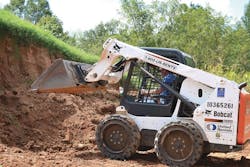A Solid Favorite: Users Prefer Solid Tires for Skid Steers and Telehandlers
A rebound in construction activity, from civil engineering projects like roads, bridges, wind farms, and airports to residential and commercial buildings, explains some of the growing demand for solid industrial tires.
“Part of the growth is simply tracking the expansion of the construction, mining and maintenance businesses that have bounced back since the recession,” says Bruce Besancon, vice president of marketing for Alliance Tire Americas Inc.
Less obvious factors are influencing demand, too.
“There’s the increase in demolition, which is necessary as we replace old buildings with new construction in crowded cities and rebuild aging infrastructure. Loading and unloading teams at ports around the world are hard at work. And there is an explosion in recycling centers and waste handling facilities, which can be among the worst environments for tires,” says Besancon.
Mike Dembe, market development manager at Camso Inc., says the trend for solid industrial tires manifests itself mostly in skid steer loaders and telescopic handlers. Wheel loaders in applications such as waste and recycling also use solid tires.
Demand for solid tires for skid steers has been trending upward for at least 15 years. Solid tires typically are more expensive than a pneumatic tire. In terms of overall cost per hour, however, the cost is lower because solid tires last up to five times longer than a pneumatic tire, according to Dembe.
The upward trend in solid tires for telescopic handlers, or telehandlers for short, is more recent. “ We’ve seen those take off in the last six to eight years. It’s a new phenomenon on that machine type. With telescopic handlers the play is the durability, predictability, and safety.”
‘The market has spoken’
Solid tires on skid steer loaders started off as a solution for only the most rugged applications, such as waste recycling and demolition, 15 years ago, according to Dembe. Today skid steer machines are used in applications from landscaping and mining to residential and commercial construction.
“A lot of users have latched onto solid tires in those applications,” says Dembe. “Skid steer loaders are some of the most versatile construction equipment on the planet. They are used literally anywhere and everywhere. The market has spoken and the market wants solid tire solutions for the added durability, lower cost per hour, predictability, and safety.”
Predictability refers to predicting and planning for tire replacement when it suits the user versus the unexpected downtime connected to replacing a failed tire. A growing awareness of the cost of downtime is helping to drive demand for solid industrial tires, according to Besancon.
“Construction, mining and material handling equipment have to keep running at all times. Downtime due to a failed tire is extremely disruptive, and today’s managers have calculated those costs to the penny. They recognize where investing in a solid tire can deliver a huge return,” says Besancon.
‘If you’re unloading a cargo vessel at a port, you’re running against the clock. If you’re running a loader in a mine shaft, changing a tire is a nightmare. At a construction site, replacing a damaged tire drags down productivity and slows down other parts of the operation. In each of those cases, a solid tire delivers unbeatable performance and peace of mind,” he says.
A trend toward holes in sidewalls
The use of holes in the sidewall, or aperture technology, is a broader industry trend in solid tires for skid steers and telehandlers, according to Dembe.
“As a tire manufacturer, we make use of apertures ,or specifically engineered holes, in the sidewall of the tire to reduce a little bit of weight but more importantly to provide a greater deflection as the tire is under load. That greater deflection translates into improved ride quality,” he says.
Introduced a year ago, Camso’s SKS 793S non-directional solid tire for skid steers has a new, elongated aperture design. Dembe says Camso’s solid tire for telehandlers, the TLH 792S, features the industry’s only triangular aperture design, which is “uniquely engineered to provide the enhanced rigidity and stability that is absolutely required for a telehandler.”
Besancon describes Alliance’s new Galaxy Beefy Baby SDS for skid steers as “a solid version of our gold-standard Beefy Baby line.” The Beefy Baby SDS was introduced in February 2016. Alliance plans to unveil more solid industrial tires at key trade shows, such as WasteExpo, later this year. ■
About the Author

Ann Neal
Ann Neal is a former senior editor at Modern Tire Dealer.
